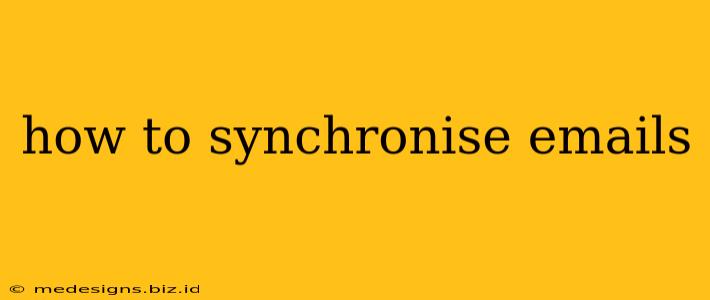Keeping your emails synced across all your devices – your phone, tablet, computer, and even your smartwatch – is crucial for staying organized and productive. This comprehensive guide will walk you through different methods and best practices for achieving seamless email synchronization. Whether you're using Gmail, Outlook, Yahoo Mail, or another provider, we've got you covered.
Understanding Email Synchronization
Email synchronization ensures that your inbox, sent items, drafts, and other folders are consistently updated across all your devices. This means that when you read an email on your phone, it's marked as read on your computer, and any changes you make are reflected everywhere. This avoids the frustration of having to manage multiple, separate email accounts.
Why is Email Synchronization Important?
- Accessibility: Access your emails anytime, anywhere, from any device.
- Organization: Maintain a consistent, unified inbox across all platforms.
- Efficiency: Avoid duplicated efforts – reply to emails once and have the response reflected everywhere.
- Productivity: Stay on top of your communications without missing important messages.
Methods for Synchronizing Your Emails
The best method for synchronizing your emails depends largely on the email provider you are using and the devices you want to connect.
1. Using Your Email Provider's App
Most major email providers – Gmail, Outlook, Yahoo Mail, etc. – offer their own dedicated mobile apps. These apps are generally the easiest and most efficient way to synchronize your emails.
-
Gmail: Download the official Gmail app for iOS or Android. Sign in with your Google account credentials, and your emails will automatically synchronize. You can customize settings for how often to sync and what data to synchronize.
-
Outlook: Microsoft offers the Outlook app for various platforms. This app supports multiple email accounts, including Gmail, Yahoo Mail, and others. Setting up synchronization is straightforward.
-
Yahoo Mail: The Yahoo Mail app is available for both iOS and Android, providing seamless synchronization with your Yahoo Mail account.
2. Using a Third-Party Email Client
For more advanced features and customization options, consider using a third-party email client like Thunderbird or eM Client. These clients often support a wider range of email providers and allow for more granular control over synchronization settings.
Benefits of Third-Party Clients:
- Unified Inbox: Manage multiple email accounts from one interface.
- Advanced Features: Filter emails, schedule messages, and use other advanced features.
- Customization: Tailor the client to your specific needs.
3. Using Webmail
Accessing your emails directly through your provider's website (webmail) is a reliable method, especially if you don't want to download additional apps. However, webmail might not offer the same level of offline access or seamless synchronization compared to dedicated apps or clients.
Troubleshooting Synchronization Issues
Occasionally, you might encounter issues with email synchronization. Here are some common troubleshooting steps:
- Check your internet connection: A weak or unstable internet connection is a frequent culprit.
- Restart your device: Sometimes a simple restart can resolve temporary glitches.
- Check app permissions: Ensure the email app has the necessary permissions to access your data.
- Update your app: Outdated apps can have synchronization bugs; update to the latest version.
- Contact your email provider: If problems persist, contact your email provider's support team.
Optimizing Email Synchronization
For optimal performance and to avoid consuming excessive data, consider these tips:
- Adjust synchronization frequency: Choose a frequency that balances convenience with data usage.
- Limit synchronized data: You can often choose to synchronize only your inbox or specific folders.
- Manage your inbox: Regularly delete or archive old emails to reduce storage and improve performance.
By following these steps and best practices, you can effectively synchronize your emails across your devices, ensuring you never miss a crucial communication. Remember to choose the method that best suits your needs and technical comfort level.
